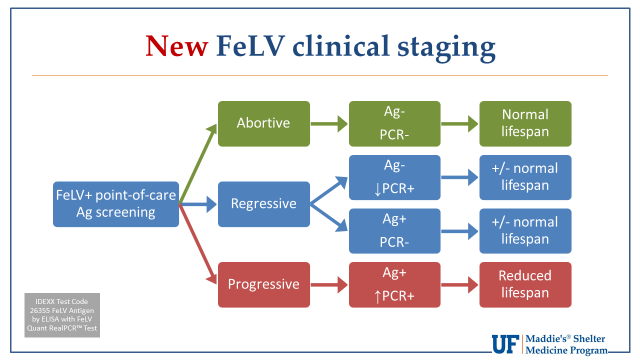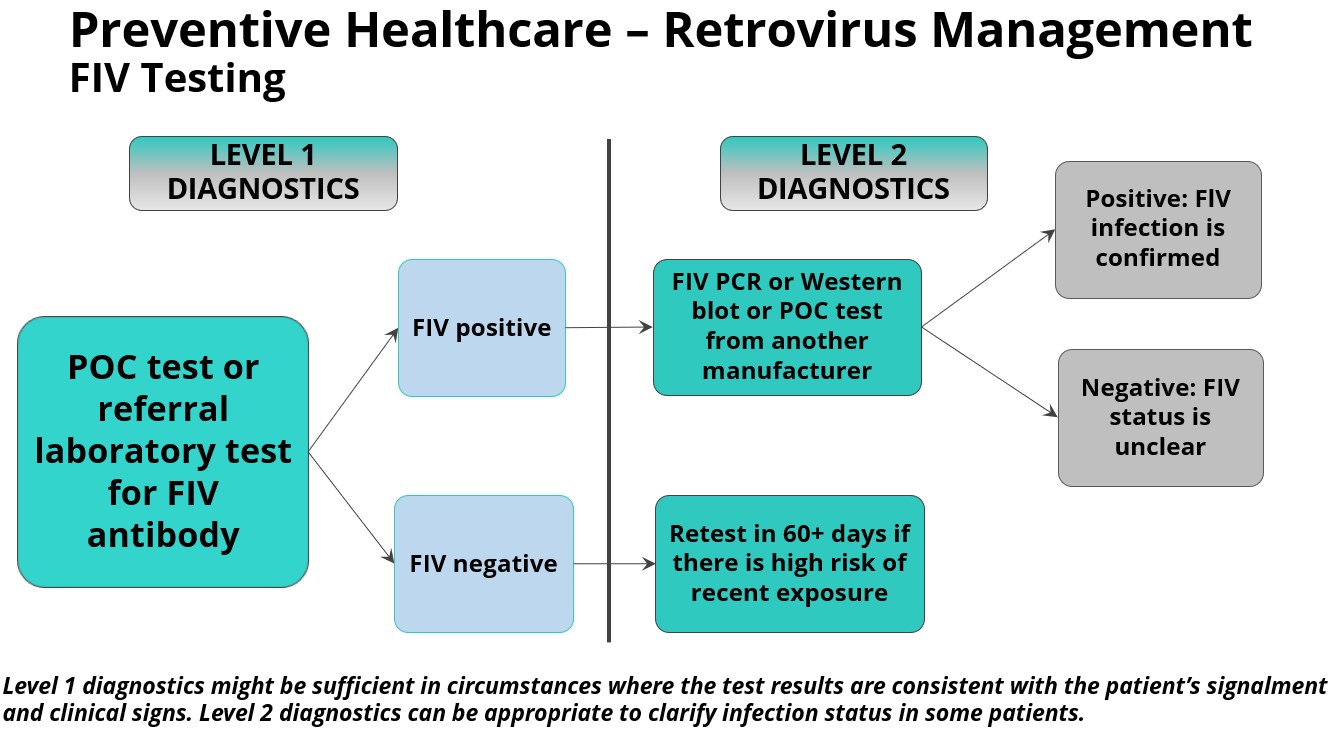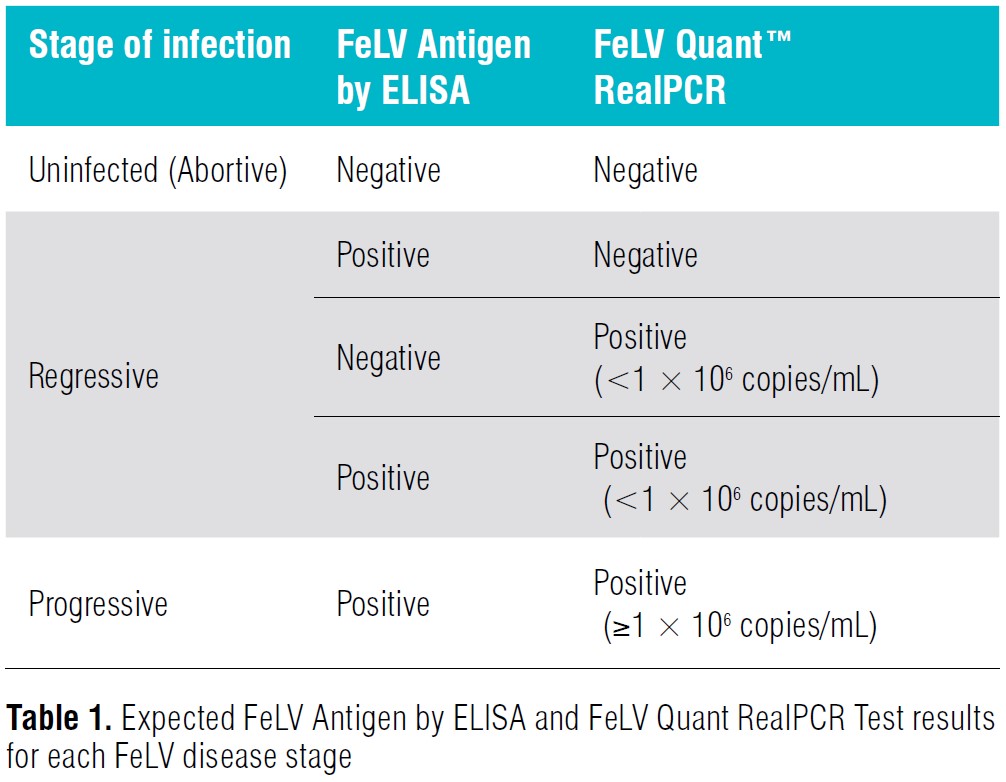+ Can I vaccinate for FeLV before testing? Does the FeLV vaccine interfere with test results?
Vaccination against FeLV does not interfere with testing for viral antigen using available point-of-care ELISA tests. However, there is no therapeutic value in administering FeLV vaccination to infected cats, and the vaccine would be unnecessary. Therefore, it is strongly recommended to test a patient prior to vaccination.
+ Do I need to test vaccinated cats for FeLV?
The FeLV status of cats, including those that have been vaccinated, should be known. Regardless of vaccination status, if a patient falls in the at-risk category, or has presented in ill health, the patient should be tested. Although commercially available FeLV vaccinations have been shown to have good efficacy, the protective effect is not 100%. As such, vaccinated cats may still be at a small risk of infection.
+ How soon after exposure can I test for FeLV?
The point-of-care FeLV ELISA test assesses for the presence of FeLV p27 viral antigen. Once exposed to the virus, patients who become infected will most likely become viral antigen-positive by 30 days post-infection. There are some exceptions to this, and any questionable situations should be re-evaluated over longer time periods or with additional laboratory testing (e.g. PCR).
+ How soon after exposure can I test for FIV?
The point-of-care FIV ELISA test assesses for the presence of antibodies against FIV. Most patients who become infected will develop antibodies as early as 60 days post-infection. Any questionable situations should be re-evaluated over longer time periods or with additional laboratory testing (e.g. PCR).
+ Can I pool blood or saliva samples from a group of cats that are housed together to test for FeLV?
Pooling samples from multiple patients is not recommended. Technically, saliva testing using point-of-care ELISA tests is less sensitive than testing blood or serum. Saliva samples are a sensitive sample source when testing for FeLV by RT-PCR. If pooled samples are used for point-of-care antigen testing, false negatives might occur, and infected cats in a group will be missed. If pooled samples are used for ELISA or RT-PCR testing, a positive sample does not identify the infected cat, thus necessitating retesting of all cats in the group individually. The ideal rule of thumb for FeLV testing is ‘one cat, one test.’
+ Can I pool blood or saliva samples from a group of cats that are housed together to test for FIV?
Pooling samples from multiple patients is not recommended for FIV testing. The point-of-care FIV ELISA test assesses for the presence of antibodies against FIV. Most patients who become infected will develop antibodies as early as 60 days post-infection. If pooled samples are used for point-of-care antibody testing, false negatives might occur, and infected cats in a group will be missed. If pooled samples are used for testing, a positive sample does not identify the infected cat, thus necessitating retesting of all cats in the group individually. The ideal rule of thumb for FIV testing is ‘one cat, one test.’
+ Why do indoor cats need testing for retroviruses?
Indoor cats are not exempt from a history of possible exposure from their queen or previous cat-cat interactions prior to acquirement. They are not exempt from the potential for exposure to retroviruses if living with other cats. While testing in most cases has good sensitivity, there are periods during a cat’s infection when testing may be negative, and thus an infection missed. The retrovirus status of all at-risk and all sick cats should be known.
+ Why isn’t one test enough to rule out FeLV?
There are three factors to consider when testing for FeLV post-exposure. The first is the time to become positive for viral p27 antigen, as detected on point-of-care ELISA testing. This can take 30 days or longer, such that a recent exposure may result in a false negative test, missing infection. The second and third factors to consider are the testing type and patient infection class. As cats that have been infected with FeLV may become regressively or progressively infected, some patients may not be positive for FeLV viral p27 antigen but may still be infected. Thus, other types of testing, such as PCR testing for FeLV proviral DNA, will further elucidate the infection status of the patient.


+ Why isn’t one test enough to rule out FIV?
The point-of-care FIV ELISA test assesses for the presence of antibodies against FIV. Most patients who become infected will develop antibodies as early as 60 days post-infection. When testing for FIV, recent exposure will not be evident by antibody testing, leading to false negatives. Further testing is necessary to elaborate on infection risks and status.
+ Should I test new stomatitis cases for FIV/FeLV even if previous tests were negative?
Yes. Even with previous testing, recent exposures or previous false negatives may exclude proper identification of retrovirus infected cats. Inflammatory oral disease is associated with an increased risk of retrovirus infection in naturally infected cats.
+ I have a patient with discordant FeLV test results, now what?
A single testing protocol is difficult to recommend for all cats. Depending on which tests were run on your patient and when, further testing, the timing of testing, and what tests to run will vary. In cases where Level 2 Diagnostics have been performed and the patient’s status remains unclear, additional Level 2 Diagnostic tests or repeat testing over time may help. During the time that the patient’s status remains unclear, the patient should be considered infectious.


+ I have a patient with discordant FIV test results, now what?
A single testing protocol is difficult to recommend for all cats. Depending on which tests were run on your patient and when, further testing, the timing of testing, and what tests to run will vary. In cases where Level 2 diagnostics have been performed and the patient’s status remains unclear, additional Level 2 Diagnostic tests or repeat testing over time may help. During the time that the patient’s status remains unclear, the patient should be considered infectious.


+ What does the quantitative real-time PCR test for FeLV tell us?
Cats that are infected with FeLV may become regressively or progressively infected. The type of infection that occurs is dependent on the patient’s immune status at the time of testing. This impacts the levels of active provirus (antigen) and/or proviral DNA. High levels of proviral DNA and antigen-positive tests are most commonly associated with progressive infections, while low levels of proviral DNA with antigen-positive or antigen-negative tests are most commonly associated with regressive infections. The quantitative real-time PCR for proviral DNA can measure the number of copies of proviral DNA, which will clarify whether the patient has a regressive or progressive infection. Regressively infected patients will have fewer than 1 million copies of proviral DNA per mL, while those patients that are progressively infected will have more than 1 million copies of proviral DNA per mL.


Courtesy of IDEXX. Copyright © 2019, IDEXX Laboratories, Inc. All rights reserved. Used with permission. Reference: Beall et al. Evaluation of a quantitative enzyme-linked immunosorbent assay for feline leukemia virus p27 antigen and comparison to proviral DNA loads by realtime polymerase chain reaction. Comp Immunol Microbiol Infect Dis. doi:10.1016/j.cimid.2019.101348
+ What recommendations do you have for communicating with clients who insist on trying unvalidated treatments found on the internet?
The AAFP and affiliates offer many client-based resources to help owners of retrovirus-infected cats sift through and look past online unvalidated treatments.
AAFP Client Brochure: download/print
Catfriendly.com Webpage: FeLV
Catfriendly.com Webpage: FIV
AAFP Client Brochure: download/print
Catfriendly.com Webpage: FeLV
Catfriendly.com Webpage: FIV
